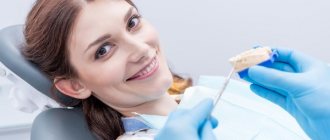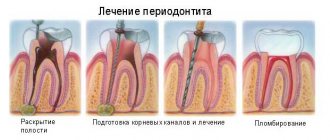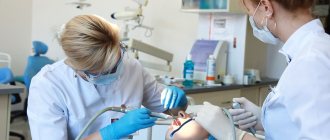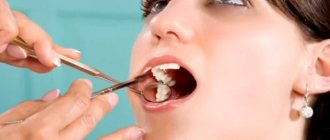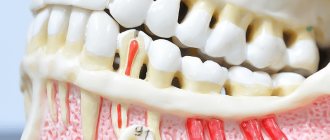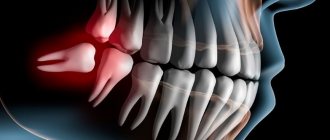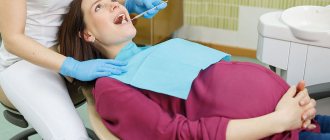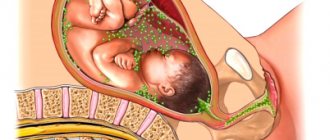Harm of X-rays for pregnant women
Sometimes, while expecting a child, women need to sanitize their oral cavity. And in order to properly plan therapy, an orthopantomogram is often required. “Is it possible to take dental x-rays during pregnancy? What are the consequences? - expectant mothers often worry.Indeed, irradiation is undesirable during this crucial period. But in reality, not everything is as scary as you might think at first glance.
Dental X-ray during early pregnancy
Directly in the first trimester, the risk of undesirable consequences is the highest, since this is when the baby’s organs are formed. For this reason, doctors do not recommend taking dental x-rays during early pregnancy. After all, cells during active division are very sensitive.
However, many doctors believe that, unlike an X-ray of the back or pelvis, a dental X-ray during pregnancy is not aimed directly at the area where the embryo is located. Therefore, do not worry if you did it before you found out about the joyful event.
In addition, dental x-rays during early pregnancy are allowed in emergency cases when, for example, there is a threat to life. In other situations, it is better to postpone dental x-rays during pregnancy to a more successful period, namely, to the second trimester.
The essence of the X-ray machine
During treatment, prosthetics or implantation, it is necessary to take dental x-rays many times: before, during and after the intervention. The devices familiar to many caused irreparable harm to the patient’s body, because the radiation dose in them is very high. This was necessary so that the reflected X-rays could be imprinted on the film, thereby creating an image.
“Classic” X-ray also required a staff member who knew how to develop images, as well as an entire darkroom. And patients had to wait a long time for examination results.
Is it possible to take dental x-rays during pregnancy?
To answer the pressing question “Is it possible to have a dental x-ray during pregnancy?” dentists answer that it is not an absolute contraindication for its implementation. Therefore, if such a study is extremely necessary for the expectant mother, it can be done. The main thing is to follow simple rules:
- So, you can take a dental x-ray during pregnancy, preferably in the second trimester. At earlier or later dates, it is better to refrain from carrying it out.
- To obtain minimal radiation exposure, you can take dental x-rays during pregnancy not with a film fluorograph, but with a computer visiograph.
- During pregnancy, you need to tell the radiologist about it and indicate the due date.
- It is necessary to cover the chest and abdomen with a special protective apron before the examination.
You should also discuss whether it is possible to have a dental x-ray during pregnancy specifically in your case with the gynecologist you are seeing. Perhaps, in order to avoid undesirable consequences, he will have his own opinion.
The whole truth about a visiograph in dentistry
Radiovisiographs came into the practice of Russian dentists more than 10 years ago, but still raise questions. The most popular is “Is this the same as an x-ray?” We answer right away: not really. We invite you to understand together the main features of the device and debunk the myths that worry doctors and patients.
How much safer is a visiograph than a regular x-ray?
The device itself is not an emitter, but only receives rays. Consists of a sensor, an analog-to-digital converter and a wire. Nowadays, most models are lightweight and are produced without a separate digitizing unit, that is, they are connected directly to the computer. There are also wireless visiographs that are placed in a special scanner to read the image.
The visiographic complex includes:
- X-ray machine;
- visiograph with software;
- computer.
Yes, the visiograph will not work without an X-ray machine. So why is it even needed then? Isn't it easier to do a regular x-ray?
Firstly, modern equipment is superior to devices of previous generations in terms of safety. If earlier installations emitted wide radiation, now a thin and targeted beam is captured by a sensitive sensor.
Secondly, the sensor recognizes even the smallest particles of radiation in less than half a second or even faster.
I would also like to note the advantage of digital visiography over film devices. Even if you take high-quality film and a good new generation of dental X-rays, it will take approximately 0.6 seconds to take a high-quality image. The same with digital radiography with a sensor is performed in 0.06 seconds. The sensor adequately perceives the signal at exposure from 0.3 tA/sec to 1.8 mA/sec.
So we have the answer to the first question. Radiovisiography is based on the same principles as conventional radiography. At the same time, the level of X-ray radiation during the operation of a radiovisiograph is much lower.
What dose of radiation do patients receive?
We believe you have heard this question from your patients more than once. When X-raying the teeth of the lower jaw using a visiograph, this value is 2 microsieverts, for the upper jaw – 5 µSv.
If film radiography is carried out using highly sensitive film and a low-dose device, the same indicator will be equal to 7 and 13 μSv. When working with old domestic equipment and low-quality film - up to 80 µSv.
How many pictures can you take? It is difficult to regulate the exact number of x-ray examinations, since not all devices are equipped with a dose counter. Accordingly, you will need to calculate it for each type of device and for each tooth. It is logical to focus on the maximum permissible effectively equivalent dose for a person per year, excluding its excess.
According to SanPiN, when carrying out preventive medical x-ray procedures and scientific research, this dose should not exceed 0.001 sievert per year (1 millisievert, 1000 microsievert). The load is equivalent to three plain chest films.
Is it possible to take dental photographs of pregnant and lactating women?
Radiovisiography is allowed only for clinical indications when there is a threat to life. We recommend that private doctors treat this with special care: for example, the patient’s signature on the card has no legal force, and all responsibility lies with the dentist.
Breastfeeding mothers can take photographs, since ionizing radiation is scattered when passing through soft tissues and biological fluids of the body. Thus, it will not affect the child in any way. To make the patient feel calmer, you can skip the next feeding after the photo.
Where can a visiograph be placed?
Since the device only works in conjunction with an X-ray machine, you must have a license that gives you the right to use equipment that generates X-ray radiation. The standard kit for obtaining a document contains a planned diagram of the office for using a visiograph.
Depending on the characteristics of specific equipment, biological protection is calculated by supervisory authorities. They also study the area of the office, the lead equivalent of the wall materials, the location of the office in the building, and the average workload of the imaging unit.
We talked more about organizing an X-ray room in our guide “How to open an X-ray room in a clinic.”
Our resume
A visiograph greatly simplifies the dentist’s work and allows you to quickly obtain digital images. Thanks to the user-friendly software, all images can be edited, archived and compared.
Despite the greater safety of the visiograph compared to standard X-ray machines, do not forget about the protection of personnel. You must stand behind a state-issued protective screen or leave the premises. If your practice has lead aprons, you can stand at least 2.5 meters to the side of the X-ray tube.
Advantages and disadvantages
X-rays allow you to accurately determine problems in the dental part of the jaw and take measures to eliminate them. In many cases, without x-rays it is impossible to make a diagnosis and prescribe treatment. Carrying out an examination allows you to minimize the risk of re-treatment, therefore, saving a pregnant or lactating woman from stress, the negative effects of which appear more often than from radiation. X-rays can be done for mothers during breastfeeding. But in any case, we perform dental x-rays for nursing mothers using all the necessary protective equipment, so you don’t have to worry about the quality of your baby’s feeding.
The disadvantage is that you receive a certain, albeit minimal, dose of radiation. It should be said that we are talking about microdoses of X-ray radiation. For example, the radiation exposure to a pregnant woman’s body during a dental examination is comparable to solar radiation on a summer day.
Dental procedures during pregnancy
X-ray.
Treatment of pulpitis and periodontitis is impossible without x-rays.
If an x-ray is prescribed for a pregnant woman, all precautions are taken.
- X-ray examination is carried out using a digital radiovisiograph. The radiation doses of this equipment are 90% lower than with film X-rays.
- During the procedure, the abdominal area is covered with a lead apron and the woman’s stay in the X-ray room is limited.
X-ray diagnostics, especially an orthopantomogram, cannot be performed in the 1st trimester of pregnancy (from 1 to 12 weeks).
Treatment of caries.
It is possible to treat caries in pregnant women, especially at the initial stage, with virtually no restrictions. If anesthesia is required, it is better to wait until the second trimester.
Tooth extraction.
Tooth extraction under local anesthesia is not contraindicated for the expectant mother. However, complex removal, such as a wisdom tooth, is best done after the birth of the child.
Anesthesia for dental treatment while expecting a child
Modern anesthetic drugs based on articaine have an exclusively local effect and do not penetrate the placental barrier. Anesthesia is absolutely safe for mother and baby.
Recommendation:
in the first 3 months, while the placenta has not yet fully formed, it is better for a pregnant woman to refrain from using anesthetics. Dental treatment with anesthesia is best done in the second trimester.
What dental procedures should not be done during pregnancy?
Teeth whitening.
Professional whitening preparations penetrate the placenta and are dangerous for the fetus at any stage.
General anesthesia and sedation.
General anesthesia drugs are prohibited for use by pregnant women.
Implantation.
During implantation, antibiotics and anti-inflammatory drugs are prescribed. Moreover, the hormonal background of a pregnant woman increases the risk of implant rejection.
Expert of the article you are reading: Bukengolts Anna Aleksandrovna Dentist-Therapist, Candidate of Medical Sciences, leading specialist of the NovaDent network
15 years
Clinical experience
Skhodnenskaya
Khimki Boulevard, 14, bldg. 2
+7
Get advice from this specialist
